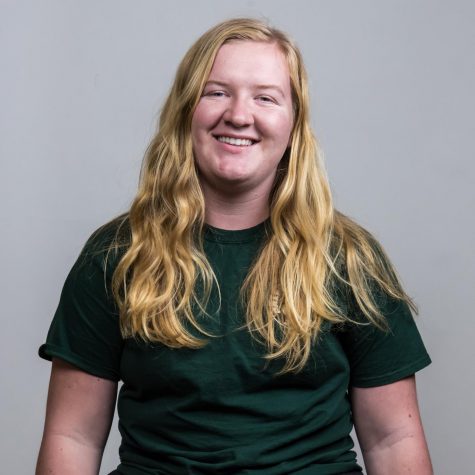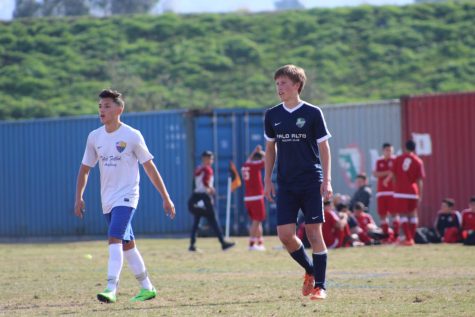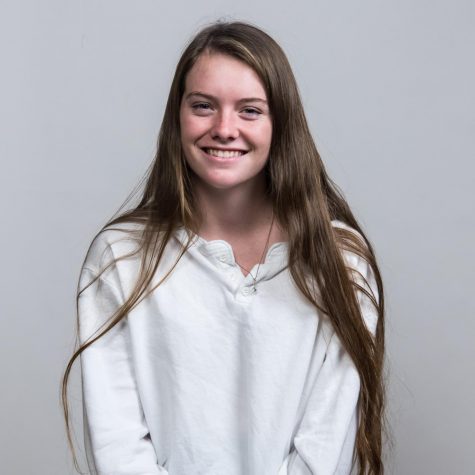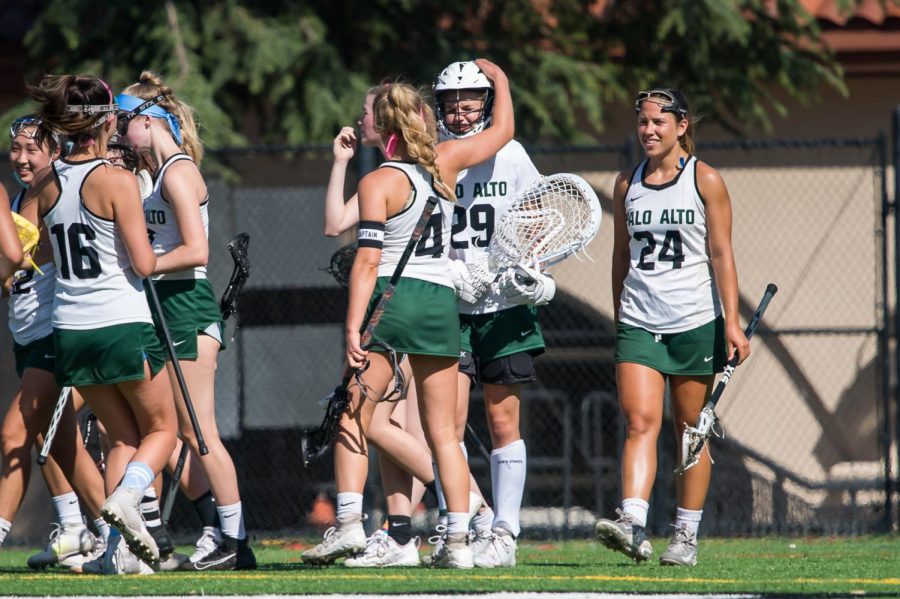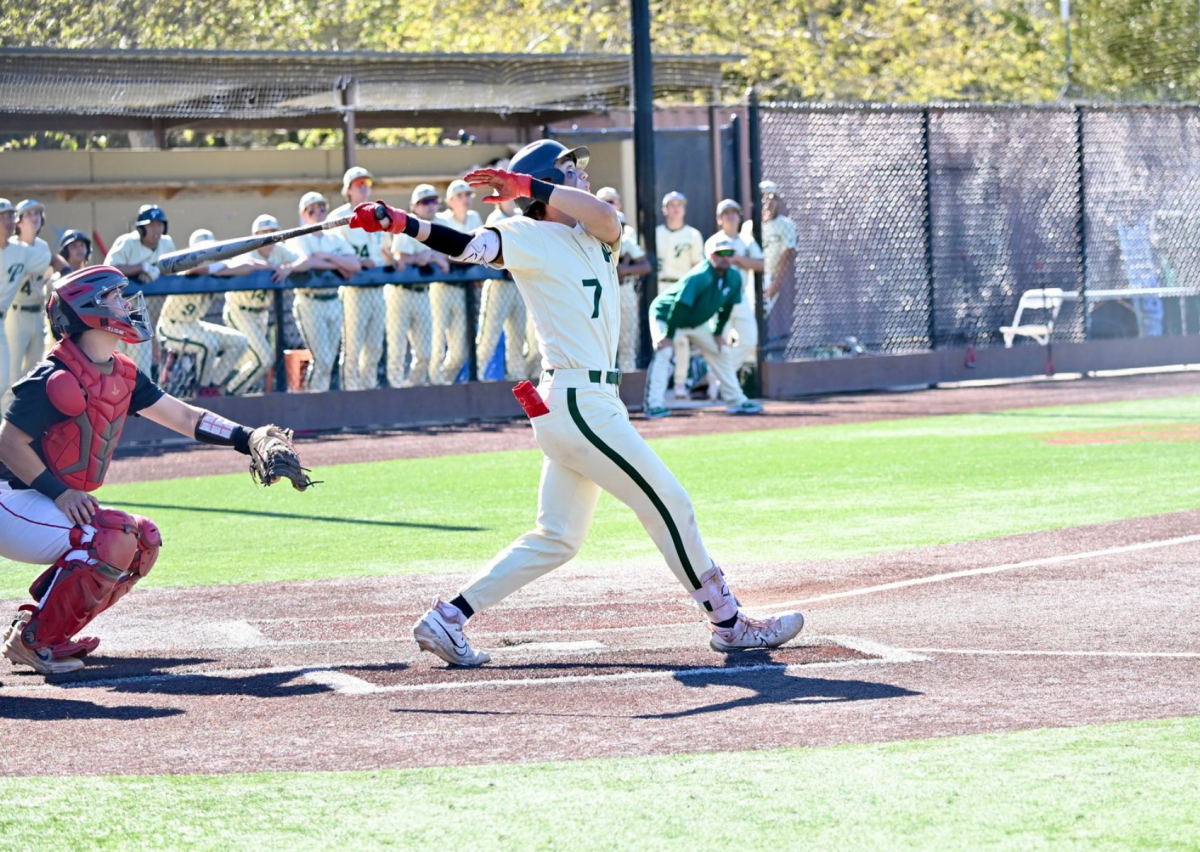And The Crowd Roared Anyways…
January 9, 2018
Viking Magazine takes a look into the athletics program at the California School for the Deaf, exploring the culture behind Deaf athletics.
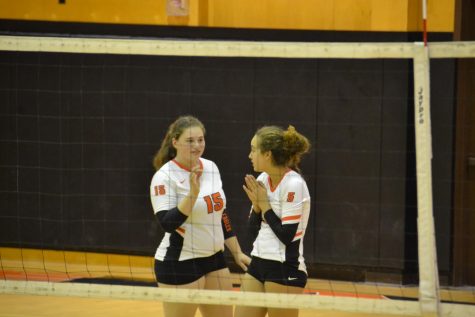
Players on the CSD volleyball team communicating on the court.
Parents and students fill the bleachers as anticipation builds. The only talking in the gym is done by the opposing team, fans are waiting for the match to begin. The match begins. CSD hammers home the last points of the first set to win and the crowd erupts. The gym had gone from mostly silent to having a roar spread throughout the crowd to support their team.
These players are Deaf and communicate with coaches and teammates by American Sign Language (ASL).
The California School for the Deaf (CSD), located in Fremont, is an elementary, middle, and high school for deaf students around the Bay Area. Deaf students come from near and far to attend this school because of the unmatched opportunity to be educated in their native language, ASL, and to be surrounded by Deaf peers and Deaf adults.
It was founded in 1860 and has had previous campuses in San Francisco and Berkeley before moving to its current 91-acre campus in Fremont. According to CSD’s website, the school is a free public school that serves deaf children.
Deaf students from ages three to 21 from 46 counties in Northern California must meet the eligibility requirement and be referred by their local school district in order to attend CSD.
Attending CSD comes at no cost to parents as the majority of the education is covered by the state of California while the student’s respective district covers the rest.
Even if students are part of the residential program, which allows students to live on campus if they live too far away for the daily commute, the program is at no cost to the students.
The school runs a bilingual program in which ASL and English are the two languages used for instruction. They aim to preserve and build upon students abilities and fluency in both languages. Students develop their expressive and receptive skills in ASL and also their abilities to read and write in English.
CSD provides full accessibility all day, so no student is ever left in a position where they are excluded due to communication. All staff members are required to be fluent in both English and ASL. Teachers must be certified in Deaf education as well as in the subject they teach.
Kevin Kovacs is a CSD alumnus and former Athletic Director, and is now the Men’s Basketball Head Coach at Gallaudet University, the only Deaf university in the world, located in Washington D.C.. He describes his experiences in both attending and coaching at CSD.
“It’s one of the best places to go as a student and as an employee,” Kevin said. “In both of my times, I learned a lot and would not be where I am today without CSD teaching me.”
Current Athletic Director and Head Varsity Football Coach Warren Keller echoes Kevin’s statement.
“It’s one of the largest Deaf schools in the country,” Keller said. “We have over 400 students and we serve the entire northern California from early childhood education to high school. We’re already pretty unique for being such a small population.”
Despite being a unique school in general, CSD’s athletic program is very dominant. CSD offers 10 varsity sports for their students to participate in. They play in the North Central II/Bay League and face schools from all around California as well as schools from out of state. CSD has a very successful athletics program which has won national championships in all of their sports. Their most recent championship came in 2016 when the boys’ basketball team defeated Rio Lindo Adventist in the NCS/Les Schwab Tires Boys’ Basketball Championships. Many other varsity teams at CSD have won championships within the past 25 years.
The biggest game of the year is the homecoming game against the California School for the Deaf, Riverside. CSD Riverside is the other Deaf school in California and is located in Southern California. On this day CSD competes against CSD Riverside in cross country, volleyball and football. Unfortunately, the game was canceled this year due to bad air quality caused by the recent Northern California wildfires.
In 2012, after posting a 10-2 record and making it to the second round of the CIF North Coast Section Playoffs, CSD’s football team gained national attention with a video done by Sports Illustrated. Before this, not many people knew about CSD or their sports teams.
Not too long after, in 2015, ESPN followed suit with their own segment titled “Silent Night Lights.” This segment brought a lot of eyes and attention towards CSD and their successful football team who was dominating against both Deaf and hearing schools.
Following this, multiple local news stations created their own segments highlighting the successful program. The national attention shed light onto people who usually do not gain much representation in the media. The year following the segment, ESPN also broadcasted one of their games, making it the first time they broadcasted a game featuring an all-Deaf team.
Current Girls’ Varsity Basketball Head Coach and second-year physical education teacher at CSD, Joshua Weinstock, believes these videos helped people recognize that Deaf athletes are no different from regular athletes.
“Opponents that once took us lightly now have shown respect because they recognize how we work hard to even the playing field,” Weinstock said.
Kevin’s sister and CSD alumna, Dyan Sue Kovacs thinks that people need to be more educated about Deaf people.
“We really need to tell the people who don’t know about Deaf people that we do function just like hearing people, just that we communicate differently. It shows hearing people that we are just humans too. We really need to expose people about our “culture” especially when the [hearing] parents have deaf children,” Dyan said.
Current CSD baseball head coach Ryan Lentz thinks the segments exposed many people to Deaf people and schools.
“The media exposure is showing everyone around the world that Deaf people are capable of doing great things,” Lentz said. “It shows that you do not need to have hearing to be a phenomenal athlete. So many Deaf students out there in this nation were born to hearing parents, and have no knowledge of American Sign Language or Deaf schools. It has been a great exposure that there are places where you can be comfortable being who you are.”
Besides producing alumni who have gone on to be successful in many different fields, successful athletes have also come from CSD. Two examples of these successes are siblings Kevin and Dyan.
Kevin graduated from CSD in 1990. He then attended Gallaudet University, receiving his BA in 1995 and MA in 1997. After he graduated, he went to Minnesota to get his first teaching job and coach youth basketball. In 2007, he made his way back to CSD to become the Youth Athletics Coordinator for one year before becoming the high school athletic director and coaching basketball at all levels. In 2015, he was offered a head coaching job at Gallaudet University for the men’s basketball team. He has been the coach there ever since.
Dyan graduated from CSD in 1992 and was inducted into the Hall of Fame for volleyball and basketball. She then went on to attend Gallaudet and was a member of the volleyball team at her time there. In 2014, she was inducted into the University’s Hall of Fame for her outstanding volleyball career. She was then an assistant coach for five years. She is currently the president of the Phoenix Deaf Women Organization. She has also won three medals for volleyball at the Deaflympics, winning bronze in 1997 in Denmark, silver in Rome in 2001, and bronze again in Melbourne in 2005. She later coached the volleyball team at Deaflympics in 2013.
The experience of being an athlete is different for everyone and each person has a unique experience.
Some Deaf athletes do not identify themselves as a “Deaf athletes”, and rather see themselves as just athletes.
“I have had great experiences growing up as an athlete,” Kevin said. “I did not see myself as a Deaf athlete but an athlete like everyone else”.
That being said, a unique thing about Deaf athletes is that they tend to know more of the other athletes personally.
“We have a lot of tournaments where we play and compete with other Deaf people around the world that we have connections with,” Kevin said. “In the Deaf world, our world is smaller and we usually know each other or have some sort of connection. If we don’t, then we usually connect and become friends.”
There is a common misconception among hearing people that Deaf people cannot play sports because they cannot hear. This is obviously not true.
“Sometimes, hearing people look at us as having a ‘disability’ so they wouldn’t want to lose to a disability team,” Dyan said. “So we play twice as hard to be able to beat them, the hearing teams feel humiliated by that. We are just humans like hearing people, too.”
Kevin also does not see being Deaf as a disadvantage, but something that is just a part of who they are.
“We all have to compete either as a Deaf or hearing person,” Kevin said. “I don’t look at our deafness as disadvantages, but we know that we cannot hear each other so we don’t hear the whistles and we do audibles with our hands and just make up for it by working hard and using our eyes more.”
While being Deaf does not affect one’s ability to be successful in a sport, Deaf athletes are often less noticed by colleges simply because of their deafness.
“The disadvantage that sticks out to me is that colleges, because of the fact that the said athlete is Deaf, often overlook the talent level of certain athletes,” Lentz said.
The major difference between Deaf and hearing teams is the way the athletes communicate with each other. While hearing teams usually communicate through speech and mostly verbally, Deaf teams communicate using ASL.
“We do not need to invent complex play codes or gestures – our signing works just fine and is too quick for the other team to catch on,” Weinstock said.
Given the players’ inability to communicate with one another through speech, coaches are not able to get players’ attention by yelling so everyone has to be more aware.
“Getting the team’s attention on the playing field or court requires being alert and teamwork in getting each other’s attention by waving or pointing to the sidelines which is much quicker than signing ‘hey, coach needs to talk to you,’ so we rely on eye contact, communicating with ASL and gestures,” Weinstock said.
Coaches get their player’s attention in different ways depending on the sport.
“We have to help each other out. I normally get the attention of my catcher or the shortstop and they, in turn, get the attention of the player I need to communicate with,” Lentz said. “I always stress to my ballplayers that they need to have their heads on a swivel to look towards me, as much as possible, as well as look to the field generals for alignments within the defense.”
CSD teams play other Deaf schools as well as hearing schools. Obviously, these can be two very different experiences for the athletes.
“Sometimes when Deaf athletes play other Deaf athletes they start to talk to each other when they probably would not if they were playing hearing opponents,” Kevin said. “The same goes for when there are Deaf referees, the Deaf athletes tend to talk a lot more to the Deaf referee because they usually cannot talk to the referee, so when there is a Deaf referee, they finally can comfortably talk as much as they want to the referee which sometimes can become too much.”
Weinstock believes that the language used to communicate among teammates is the biggest difference between playing Deaf opponents versus those who can hear.
“The biggest difference between Deaf and hearing opponents clearly is the sign language,” Weinstock said. “Our players are used to ignoring hearing players’ trash talk on the court, but with Deaf players it is difficult. Deaf opponents can also see our signs so we adjust how we use our play signs. We help each other out when the referee signals stoppage of play as a show of sportsmanship.”
Since most Deaf athletes know each other, playing Deaf people can be mean more to the athletes.
“The Deaf community is small, so playing against Deaf opponents becomes more meaningful to us,” Dyan said. “Once we beat those teams, we will talk about it for decades and decades- generation to generation. However for me, it really feels good when we beat a great hearing team. For example, there was a high school team (Head Royce) that was “impossible” to beat. In my sophomore year, we beat them in basketball. They left with a lot of tears.”
Because the athletes tend to know most of the athletes from other Deaf schools, the games can feel like more than just a game.
“When we play against other Deaf schools, it is always a big thrill for our athletes, regardless of the sport,” Lentz said. “Our athletes get a chance to compete with their friends that they have met through other Deaf sports events from previous years, or against their friends that they met through Deaf camps throughout the summer. There is always a big sense that it is more than a game, it brings the national community closer together.”
CSD has had a very long and rich history of athletic success. Being an athlete comes along with holding on to some of the most memorable moments for the rest of your life.
Dyan vividly remembers some of the best moments. One of her favorite memories from CSD was winning the Deaf national championship for volleyball in 1991.
“Our record was 20-5 that year,” Dyan said. “Our team is one of two national championship teams from CSD history, so it’s a huge honor for us.”
At Gallaudet, she remembers the team rallying together and working extremely hard after losing to the same team twice.
“Our senior year at Gallaudet (1995) we were 41-4 and lost to the same team twice. Our hearts were wrecked. In the spring before the season, my coach told me that we need to have at least four players to practice at six a.m. and I made sure of that. The result was worth it.”
Her brother, Kevin’s favorite moment at CSD, is also the most memorable game in Weinstock’s mind. Kevin was the boys’ varsity basketball head coach at the time and their most memorable game was winning the North Coast Section Division VI Boys Basketball Championship in 2014.
“It was very sweet because we had a wonderful group of humble guys who were more than willing to make a sacrifice for the guy next to them in order to achieve something they would not be able to do by themselves,” Kevin said. “This made it a lot sweeter than the 25th win and NCS championship.”
Weinstock agrees
“We played St. Elizabeth, a league rival for the third time on our home court. The game was delayed two hours because of a scheduling mistake, and there were no officials at the game,” Weinstock said. “The buildup at the gym was incredible and the team won a hard fought game 55-47 under Head Coach Kevin Kovacs.”
Debbie Ayres is a hearing PE teacher at CSD and former Girls’ Varsity Basketball Coach. Prior to coaching at CSD, she taught and coached at many levels, including coaching Division I women’s basketball.
“I had heard about the school for the Deaf when I was graduating college,” Ayres said. “At that time, I thought I would like to coach a Deaf basketball team someday,”
She applied for a job at CSD and they hired her based on her collegiate coaching experience and work with Pat Summitt. However, when she was hired, she did not know ASL.
“Hiring me did not make some Deaf people happy because I was a hearing person, who did not know ASL,” Ayres said. “I took ASL classes in the evening, taught PE at CSD and coached the CSD girls’ varsity team for 6 years.”
Under Ayres, the team was successful in competing against Deaf and hearing teams in their Division V league. Ayres also coached the USA Deaf National team to a gold medal in the World Games for the Deaf in Athens, Greece and coached the USA Deaf National team to a gold medal in Poland in the U21 World Games. She is still on the board for the USA Deaf Basketball Federation.
In 2003, Ayres left CSD to coach college basketball in New York before coming back to CSD in 2006.
“When I returned, things had changed,” Ayres said. “More opportunities became available for the Deaf due to technology. The school offered ASL classes; so that, students could learn the language in a formal way. ASL gained respect by being identified as a language from linguists,”
When coaching Deaf athletes, Ayres has to use alternative ways to get their attention.
“Sometimes, we would continue to make a lay-up after the whistle and I stomped my right foot on the hardwood floor to gain my players attention by feeling the vibrations across the floor,” Ayres said. “I really could only communicate with them when play had stopped (i.e., free throw, out of bounds).”
Current athletic director and football coach, Warren Keller has done so much for CSD’s athletic program. Keller grew up wanting to be a coach. His first experience in coaching came when his younger sister’s softball coach got pregnant and Keller stepped in to help and loved it.
Keller then went on to coach youth Deaflympics and intramurals while he was in college. His first job was starting the athletics program at Sequoia School for the Deaf which was a small mainstreamed program in Mesa, Arizona. He then came to CSD.
“I wanted to work at a large Deaf school where high-level competition started so I knew that there was no place better than CSD for that,” Keller said.
When he came to CSD, he taught PE and coached various sports, such as football, basketball, baseball and softball, while learning from others until he became the head varsity football coach in 2012.
“Two years ago, our former Athletic Director left to coach Gallaudet University Men’s’ Basketball Program so I thought this would be my best opportunity to not just be involved with football, but the entire student body,” Keller said.
Weinstock began coaching at CSD because of Keller.
“I began coaching because of Warren Keller, our current Athletic Director, at that time was just the Varsity Football Head Coach,” Weinstock said. “He sat down with me and shared his vision, passion and dreams for building a program. I wanted to be part of that too, to see our student-athletes grow on and off the field.”
Keller also believes that the national exposure has benefitted many Deaf students.
“It makes me proud that CSD has represented the Deaf community well and that ESPN and other media outlets has portrayed deafness the right way,” Keller said. “We have been learning that the CSD story over the years has really made a difference and improved many Deaf students and schools’ situations right now”
The uniqueness of CSD and its athletic program is apparent even to current athletes.
Senior Tivon LeMaster plays football, basketball and baseball. When asked why he believes CSD is unique he answered, “full Deaf communication with all students and staffs so we can understand together.”
LeMaster thinks that the biggest misconception that hearing people have is that they believe Deaf people can’t play sports because they can’t hear.
“Most hearing people think that Deaf athletes can’t play any sports because we can’t hear anything, that is not true because we are very useful with our eyes to see everything,” LeMaster said. “Some hearing people think that Deaf people can’t play like pro athletes, and that is not true too because there are Deaf pro athletes.”
LeMaster believes that the national attention brought to CSD helped inform people who have deaf children
“ESPN helped CSD and all people who have deaf children by showing them it is best for them to go to their Deaf school to have success in life,” LeMaster said.
CSD junior Malia Zornoza plays four sports, volleyball, basketball, softball and track. She believes CSD’s athletic program is unique because many of the athletes play several sports.
Like LeMaster, Zornoza thinks that the most common misconception is that Deaf people cannot play sports successfully.
“Some people don’t know that Deaf people can play,” Zornoza said. “Many people wonder how we communicate on the court and/or field.”
She believes that the segments on ESPN and Sports Illustrated helped educate people.
“It shows that we can play and it spread knowledge of Deaf schools all over America,” Zornoza said.
CSD’s athletic program is extremely dominant and has been for many years because athletes like LeMaster and Zornoza work hard every day.
“We hope to show and inspire people that Deaf people can do anything,” Weinstock said. “Now our athletes are motivated to better themselves and take our athletic programs to new heights.”



